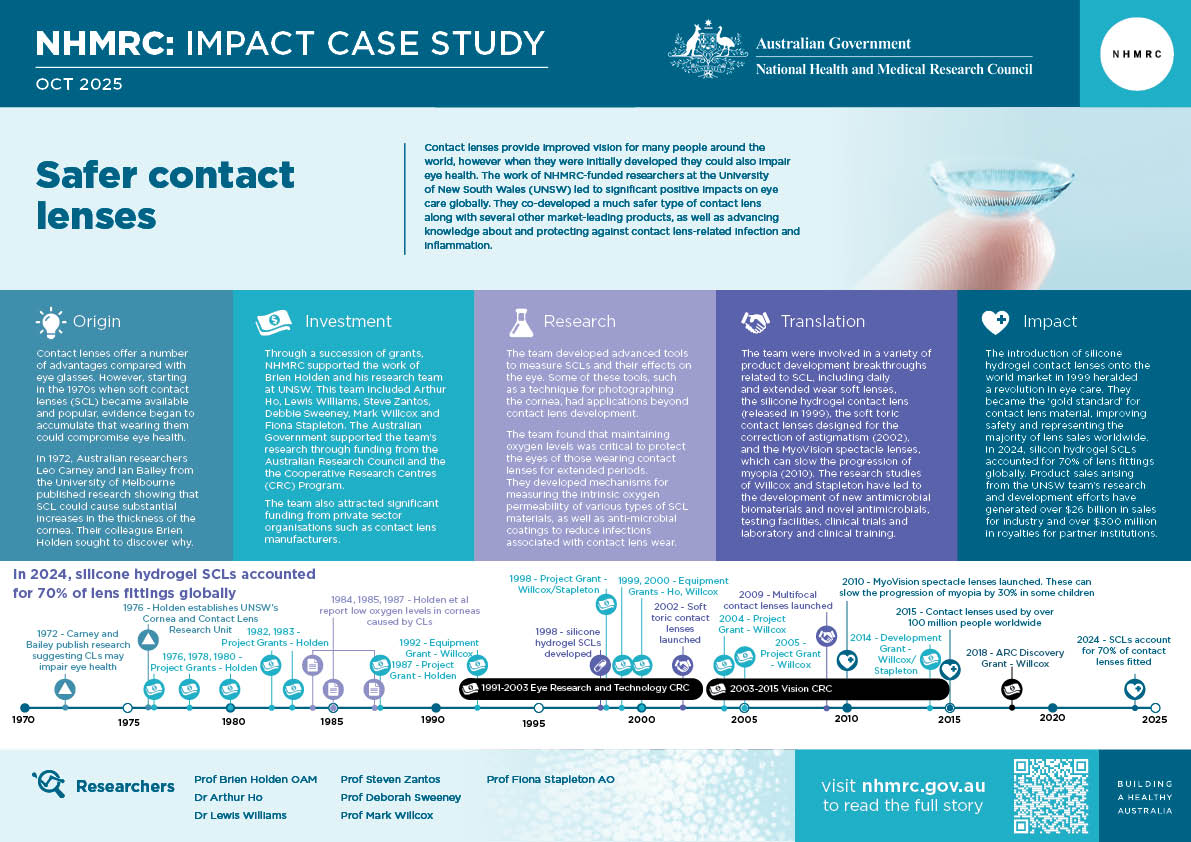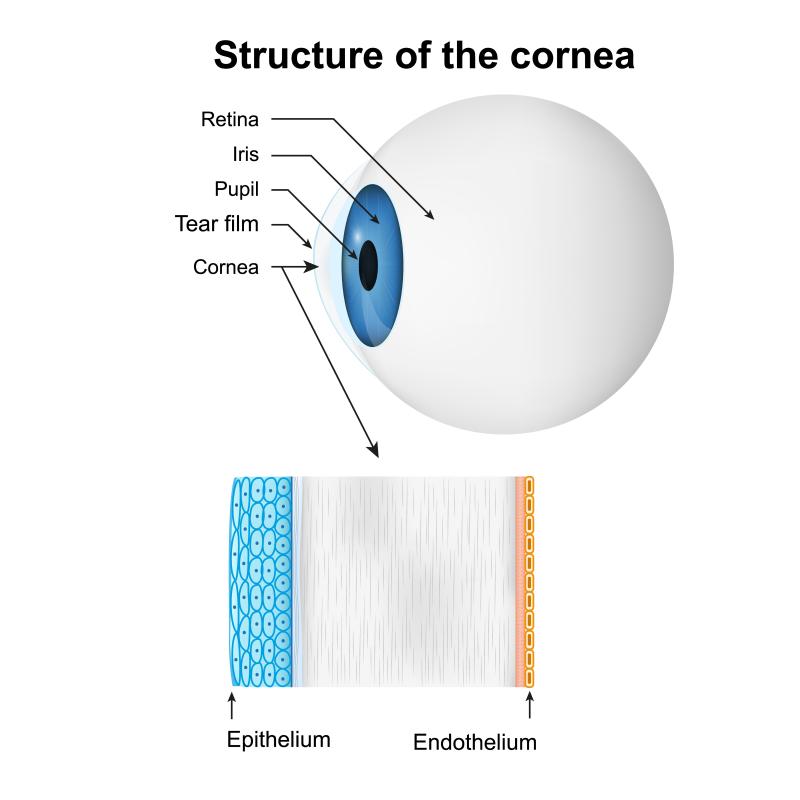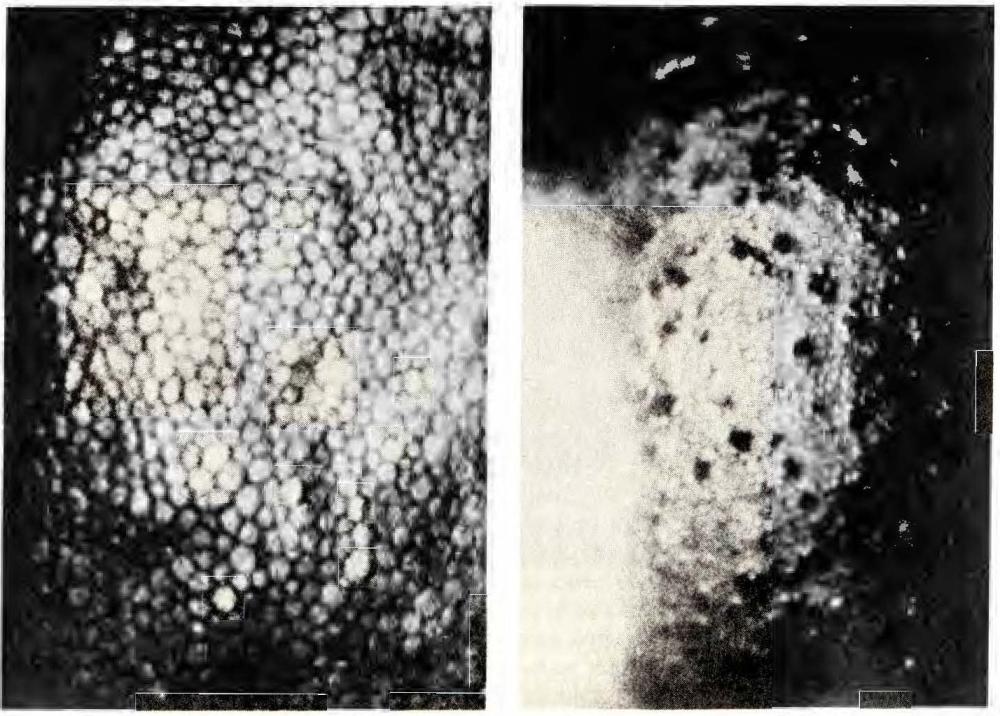Contact lenses provide improved vision for many people around the world, however when they were initially developed they could also impair eye health. The work of NHMRC-funded researchers at the University of New South Wales (UNSW) led to significant positive impacts on eye care globally. These included the development of a much safer type of contact lens along with several other market-leading products, and advancing knowledge about contact lens-related infection and inflammation.
Origin
Spectacles, or at least magnifying glasses to help with reading and seeing close-up, existed many hundreds of years ago and possibly even in ancient China.1 However, it wasn’t until the late 1800s that the first successful type of contact lens was produced. This was made of glass and worn directly against the surface of the eye. The first hydrophilic (‘water loving’) soft contact lens (SCL) was produced in 1959.
Contact lenses offer a number of advantages compared with eye-glasses. Because they conform and sit close to the wearer’s eyes, contacts provide a wider field of vision with less distortion and obstruction. They don't slip or slide down when the wearer is active or exercising, they aren’t affected by the weather and they don't fog up when temperatures change. Contacts don’t pinch behind the wearer’s ears or exert pressure on the bridge of their nose (which can cause headaches and discomfort) and, unlike glasses, contacts don’t obstruct other people’s view of the wearer’s face.
Moreover, continuous wearing of SCL is advantageous in the correction of many visual defects. For babies and young children, the correction of visual defects before the end of the critical period of visual development significantly enhances the possibility of development of normal vision. Contact lenses are also vital for patients who have had cataracts removed. Not only can the problems of tunnel vision, restricted field of view and severe and disorientating changes in magnification be overcome with contact lenses, but such visual problems, usually combined with other physical handicaps, often make it extremely difficult for cataract patients to remove, clean and insert the lenses. In these cases, continuous wear contact lenses are almost essential.
Despite the importance of continuous wear contacts for eyesight, by the early 1970s, evidence had begun to accumulate that continuous wear could also compromise ocular health, causing side-effects such as visual distortion, oedema (fluid build-up in the eye), mechanical damage, infection and corneal exhaustion.
In 1972, Australian researchers Leo Carney and Ian Bailey from the University of Melbourne published research showing that SCL could cause substantial increases in the thickness of the cornea. They noted that these thickness changes indicated disturbance of normal corneal functioning, but also that it was not clear what the clinical significance of these changes was.2
It would be another University of Melbourne graduate, Brien Holden, who would take the next steps with this research and – in the process – revolutionise the international contact lens industry.
Investment
Through a succession of grants, NHMRC supported the work of Brien Holden, Arthur Ho, Deborah Sweeney, Mark Willcox, and Fiona Stapleton, as well as team members Lewis Williams and Steve Zantos.
Their research was undertaken within UNSW’s Cornea and Contact Lens Research Unit (CCLRU), which Holden established in 1976. In 1985, the CCLRU became the Institute for Eye Research, and in 2010 was renamed the Brien Holden Vision Institute.
Apart from NHMRC funding, the Australian Government also supported the team’s research through the Australian Research Council, and through the Cooperative Research Centres (CRC) Program, via the CRC for Eye Research and Technology (CRCERT) (1991–2003) and then the Vision CRC (2003–2015), which became the largest vision correction research centre in the world.
The team’s research also attracted considerable funding from the contact lens industry and also through sales of contact lenses in Australia via a National Cornea and Contact Lens Research Fund.

The PDF poster version of this case study includes a graphical time showing NHMRC grants provided and other events described in the case study.
Research
In 1971, and following PhD training in the UK, Holden joined UNSW’s Department of Optometry. Then, in 1973, Holden published one of his earliest papers, which highlighted some of the health effects of contact lens wear. These included: limbal hyperemia (red eyes), hypoxia (lack of oxygen to the cornea), discomfort and discontinuation of lens wear (primarily hard lenses) and the need for extended wear. These were to become the research cornerstones for the international optometry/contact lens research community over the next four decades.3
SCL first became available in Australia in the early 1970s and from that time – and internationally – a key focus among optometric researchers was measuring how much oxygen was reaching the cornea through different types of contact lenses.
Commencing in 1973, and alongside postgraduate students Lewis Williams, Steve Zantos and Arthur Ho, Holden began research to determine what was needed in contact lenses to maintain eye health. By 1976, now as part of UNSW’s CCLRU, the development of this group had grown to over 30 people, the largest in the world engaged in this area of research.
The CCLRU team built measurement systems to measure SCLs, superior to anything available elsewhere in the world at that time.

Holden, Ho and Stephen Payor co-developed the first high-precision optical pachometer, designed to measure the thickness of the cornea, and to measure the overall stress placed on the cornea from wearing contact lenses. Linked to a computer, this device could measure both the cornea and the swelling of its individual layers.
A new method of photographing the corneal endothelium (the innermost layer of the cornea) was also developed, to measure the effect of contact lens wear on the eye. The method used a binocular microscope, allowing a large endothelial area to be consistently located and photographed.
This system has had many applications in ophthalmology other than in contact lens work and it led to the discovery of a previously unknown side effect of contact lens wear, being temporary changes occurring in the corneal endothelium when contact lenses were first placed on the eye. The reaction, which appears as dark patches among the endothelial cells, is caused by the contact lens blocking the oxygen supply to the cornea. It is the same physiological change which appears when the eye closes and the eyelid shuts off the airflow.
This observation questioned the previously accepted view that the endothelium was unaffected by variation in the external corneal environment and it also raised the question of the basic effects of contact lens wear.

During the 1980s Holden and colleagues published a series of key papers including on:
- Critical oxygen levels to avoid corneal edema for daily and extended wear contact lenses (1984)5
- Effects of long-term extended contact lens wear on the human cornea (1985)6
- The oxygen permeability of rigid gas permeable contact lenses: Reaching a consensus (1987).7
Important scientific contributions made by Holden’s team also included specifying the minimum oxygen transmissibility required to avoid excessive levels of corneal edema during daily and extended contact lens wear. Conducted with colleague Dr George Mertz, this seminal work established what became known as the ‘Holden-Mertz criterion’ and laid much of the foundation for the later invention of silicone hydrogel contact lenses.
During the period 1985 to 1994, the team further developed methods for the definition of the oxygen needs of the eye, as well as methods of using and screening extended wear lenses.
Commencing in 1992, team members Mark Willcox and Fiona Stapleton commenced a program of work related to infections associated with contact lenses and other medical devices. Their work focused on the development of novel antimicrobials with applications as antibiotics and disinfectants, as well as on understanding the causes of adverse events and discomfort during contact lens wear, including due to adhesion and biofilm formation by microbes.
Willcox and Stapleton developed new antimicrobial coatings that can be used for a variety of purposes, including coating of medical devices to reduce associated infections. Several of these have been taken through to pre-clinical testing, and antimicrobial contact lenses through to Phase III clinical trials.
Willcox and Stapleton have established several biological based models for studying contact lens adverse events and biomaterial infections. Their research has also encompassed studies of the tear film (a thin oil/liquid coating that covers the surface of the eye) and its interaction with contact lenses. They have applied new techniques that allow the quantification of individual proteins and lipids that adsorb onto contact lenses, or are biomarkers for changes to the ocular surface. This has allowed researchers, for the first time, to be able to assess the contribution of particular proteins or lipids to the production of adverse responses during lens wear. Willcox and Stapleton have also investigated the use of tears as the source of biomarkers for diabetes, breast and prostate cancer.
Translation
Holden and colleagues were involved in many product development and research breakthroughs. These included:
- 1972 – comfortable, well performing daily wear hydrogel spherical and toric lenses
- 1975 – extended wear soft lenses
- 1983 – the first centre-distance and centre-near soft bifocal combination for treating presbyopia with concentric bifocal contact lenses
- 1998 – the silicone hydrogel contact lens
- 2002 – soft toric contact lenses design for the correction of astigmatism. This won a patent design award from the US Patent Office for novel and excellent design.
- 2009 – multifocal contact lenses for correction of presbyopia
- 2010 – spectacle lens designed to slow the progression of myopia by 30% in children with at least one myopic parent.
The research studies of Willcox and Stapleton have led to the publication of 15 patents. Their laboratory works closely with industry to provide potential new antimicrobial biomaterials and novel antimicrobials, testing facilities, clinical trials and laboratory and clinical training.
Outcomes and impacts
While in 1970 there were only about 2 million contact lens wearers worldwide,8 by 2025 there are estimated to be well over 100 million wearers.
The introduction of silicone hydrogel contact lenses onto the world market in 1999 heralded a revolution in eye care. They became the ‘gold standard’ for contact lens material, improving safety and representing the majority of lens sales worldwide. In 2024, silicon hydrogel SCLs accounted for 70% of lens fittings globally.9
Product sales arising from the UNSW team’s research and development efforts have generated over $26 billion in sales for industry and over $300 million in royalties for partner institutions.10,11
Researchers
Professor Brien Holden OAM
Brien Anthony Holden (1943–2015) completed an optometry course at the University of Melbourne in 1964, then completing his PhD in corneal and contact lens research at the City University London in 1971. He returned to Australia to take up a position as lecturer at UNSW, where he remained until 2015. Holden was President of the International Association of Contact Lens Educators (IACLE) from 1991 to 2000. In 1997, Holden was awarded the Medal of the Order of Australia for service to optometry, contact lens research and education. In 2014, Holden was a recipient of the American Academy of Optometry’s highest honour, the Charles F. Prentice Medal.
Dr Arthur Ho
Arthur Ho is currently the Chief Scientist and Innovation Officer at BHVI, in addition to an appointment as a Conjoint Professor at the School of Optometry and Vision Science, UNSW. He is a Voluntary Professor of Ophthalmology at the Miller’s School of Medicine, and Adjunct Professor of Biomedical Engineering at the Department of Biomedical Engineering, both at the University of Miami. Ho is named as an inventor on over 70 issued patents and over 80 pending applications.
Dr Lewis Williams
Lewis Williams graduated in optometry from Queensland Institute of Technology (QUT) and then received Masters and PhD degrees in optometry at UNSW. Williams spent nine years in the Australian and New Zealand contact lens industries in various roles before joining IACLE, where he is now Director of Educational Development. IACLE’s Fellowship Examination is currently the only accreditation system for contact lens educators worldwide. Williams has been part of the IACLE team for almost 25 years. He is also an Adjunct Senior Lecturer at the UNSW School of Optometry and Vision Science.
Professor Steve Zantos
Following his PhD research at UNSW, Steve Zantos went on to become Professor of Clinical Optometry at UNSW, Optometry Australia national director and President of the Contact Lens Society of Australia. He currently works as the Optometry Services Manager at the Vision Eye Institute in Sydney.
Professor Debbie Sweeney
Deborah Sweeney received her Bachelor of Optometry from UNSW in 1980, then joined the CCLRU. After completing her PhD in 1992, she held various executive roles within CCLRU and the Vision CRC (and its predecessor) including five years as Chief Executive Officer of Vision CRC.
Sweeney joined the University of Western Sydney in 2009 and is now Deputy Vice-Chancellor and Vice-President (Research, Enterprise and International). She served as IACLE President from 2000 to 2011, and as Secretary and Treasurer for 10 years, having first become a member in 1990.
Professor Mark Willcox
Mark Duncan Willcox completed a BSc in Applied Biology at the University of the West of England (1983) then a PhD in Medical Microbiology/Dentistry at the University of Manchester (1987). In 2015 he was awarded a DSc in ocular surface research from UNSW.
In 1993, Willcox became a Research Fellow at the Institute of Dental Research at Westmead Hospital, Australia. In 2013 he became Director of Research at UNSW’s School of Optometry and Vision Science and in 2014, the Associate Dean Research Training in UNSW’s Faculty of Science. Willcox is past President of the International Society for Contact Lens Research (ISCLU).
Willcox has received numerous awards, including the British Contact Lens Association Medal (2011), the Max Schapero Award from the American Academy of Optometry (2011), the J Lloyd Hewett Award from the journal of Clinical Experimental Optometry (2016), the BCLA Dallos Award (2017), and the Korb Award for Excellence from the American Optometric Association (2020).
Scientia Professor Fiona Stapleton AO
Fiona Stapleton completed a BSc in Optometry at the University of Wales, Cardiff (1985), then a MSc (by research) from the University of Manchester (1988) and a PhD at the City University, London and Moorfields Eye Hospital (1991).
Stapleton was Visiting Research Fellow at CRCERT (1993) then became a Senior Lecturer at CCLRU (1994–2000). She was Head of the School of Optometry and Vision Science, UNSW (2007–2019), Professor of Optometry (2008–2019), became Scientia Professor in 2019 and was Associate Dean (Enterprise), Faculty of Science (2020–2022). Stapleton has been President of the ISCLU since 2019.
Stapleton has received numerous international awards including the American Optometric Association Don Korb Award, the American Optometric Foundation Glen A Fry Award, the Australian Optometry HB Collin Medal and the UK Hospital Optometrists Woodward Medal. In 2023, Stapleton was appointed an Officer of the Order of Australia for distinguished service to optometry as a researcher, mentor and role model, to tertiary education, and to national and international organisations.
Partners
This case study was developed with input from Professor Michael Collins (QUT), Professor Mark Willcox and Professor Fiona Stapleton AO and in partnership with UNSW.

References
The information and images from which impact case studies are produced may be obtained from a number of sources including our case study partner, NHMRC’s internal records and publicly available materials. Key sources of information consulted for this case study include:
1 Charlesworth PR. History of Chinese spectacles. Chinese Medical Journal. 1938;53(04):379-90
2 Carney LG, Bailey IL. (1972) Hydrophilic Contact Lenses-Their Effect on the Cornea. Australian Journal of Optometry, 55, pp. 161-163
3 Holden BA. The present and future of contact lenses. Aust J Optom 1973;56: 429442
4 National Health and Medical Research Council. National Health and Medical Research Council Report for 1978. Parliamentary Paper No. 372/1979. Canberra, November 1979. The Parliament of Australia
5 Holden BA, Mertz GW. Critical oxygen levels to avoid corneal edema for daily and extended wear contact lenses. Invest Ophthalmol Vis Sci 1984;25:1161-1167
6 Holden BA, Sweeney DF, Vannas A, et al. Effects of longterm extended contact lens wear on the human cornea. Invest Ophthalmol Vis Sci 1985;26: 1489501
7 Efron, Nathan, Brennan, Noel A., & Holden, Brien A. (1987) The oxygen permeability of rigid gas permeable contact lenses: Reaching a consensus. Contact Lens and Anterior Eye, 4, pp. 62-66.
8 Morgan PB et al. International contact lens prescribing in 2024. A report on trends in global contact lens prescribing from our 24th consecutive annual survey. Contact Lens Spectrum. January 1, 2025 Vol 40, Issue January/February 2025 Pages: 22-24, 26, 28-30. Available from: [https://www.clspectrum.com/issues/2025/january-february-2025/international-contact-lens-prescribing-in-2024(https://www.clspectrum.com/issues/2025/january-february-2025/international-contact-lens-prescribing-in-2024)
9 Morgan PB et al. International contact lens prescribing in 2024. A report on trends in global contact lens prescribing from our 24th consecutive annual survey. Contact Lens Spectrum. January 1, 2025 Vol 40, Issue January/February 2025 Pages: 22-24, 26, 28-30.
10 Remembering Professor Brien Holden four years on | Brien Holden Foundation. Available from: https://www.brienholdenfoundation.org/remembering-professor-brien-holden-four-years-on. Accessed 3 October 2025
11 UNSW researchers top vision IP list. 3 June 2015. Available from https://bhvi.org/news/unsw-researchers-top-vision-ip-list/. Accessed 3 October 2025